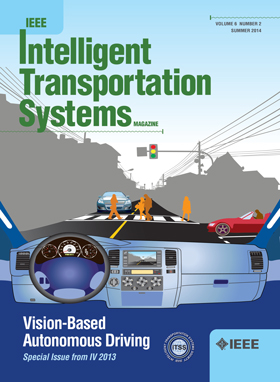DUCTNet:复杂场景下无人机遥感图像中的有效路面裂缝分割方法
IF 7.9
1区 工程技术
Q1 ENGINEERING, CIVIL
IEEE Transactions on Intelligent Transportation Systems
Pub Date : 2024-04-15
DOI:10.1109/TITS.2024.3384018
引用次数: 0
摘要
复杂场景下的道路裂缝检测面临着车辆、交通设施、道路印刷标志和细小裂缝的挑战。为了更好地解决这些问题,本文提出了一种新颖的深度 U 型密集嵌套裂缝图像分割网络结构,命名为 DUCTNet。首先,结合 Unet++ 密集嵌套结构和 U2Net 深度嵌套结构的优越性能,设计了一种深度密集嵌套结构。这种结构提高了模型提取深度裂纹特征的能力。其次,提出了一种新颖的深度竞争融合特征提取块。它通过竞争性融合提高了裂缝与背景之间的特征相似性。然后,提出了一种新颖的高密度特征融合关注机制。该方法通过提高特征密度,增强了裂缝在水平和垂直方向上的上下文信息和敏感信息。最后,DUCTNet 在自建数据集和四个公开数据集中与八个最先进的专业裂缝分割网络进行了对比测试,取得了最佳结果。此外,DUCTNet 在实际道路测试中也取得了优异的成绩,这证明 DUCTNet 可以为工程技术人员提供更好的道路裂缝检测手段。本文章由计算机程序翻译,如有差异,请以英文原文为准。
DUCTNet: An Effective Road Crack Segmentation Method in UAV Remote Sensing Images Under Complex Scenes
Road crack detection in complex scenarios is challenged by vehicles, traffic facilities, road printed signs and fine cracks. In order to better solve these problems, a novel dense nested depth U-shaped structure for crack image segmentation network named DUCTNet is proposed. Firstly, a depth dense nested structure is designed by combining the superior performance of the Unet++ dense nested structure and the deep nested structure of U2Net. This structure improves the ability of the model to extract crack features in depth. Second, a novel deep competitive fusion feature extraction block is proposed. It improves the feature dissimilarity between the cracks and the background by competitive fusion. Then, a novel high-density feature fusion attention mechanism is proposed. This method enhances the contextual and sensitive information of cracks both horizontally and vertically by increasing the feature density. Finally, DUCTNet achieves the best results in comparison tests with eight state-of-the-art specialized crack segmentation networks in both self-built datasets and four public datasets. In addition, DUCTNet achieves excellent results in real road tests, which proves that DUCTNet can provide engineers and technicians with a better means of detecting road cracks.
求助全文
通过发布文献求助,成功后即可免费获取论文全文。
去求助
来源期刊

IEEE Transactions on Intelligent Transportation Systems
工程技术-工程:电子与电气
CiteScore
14.80
自引率
12.90%
发文量
1872
审稿时长
7.5 months
期刊介绍:
The theoretical, experimental and operational aspects of electrical and electronics engineering and information technologies as applied to Intelligent Transportation Systems (ITS). Intelligent Transportation Systems are defined as those systems utilizing synergistic technologies and systems engineering concepts to develop and improve transportation systems of all kinds. The scope of this interdisciplinary activity includes the promotion, consolidation and coordination of ITS technical activities among IEEE entities, and providing a focus for cooperative activities, both internally and externally.
 求助内容:
求助内容: 应助结果提醒方式:
应助结果提醒方式:


